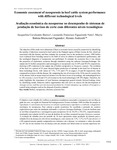Please use this identifier to cite or link to this item:
http://www.alice.cnptia.embrapa.br/alice/handle/doc/921190Full metadata record
| DC Field | Value | Language |
|---|---|---|
| dc.contributor.author | BARROS, J. C. | pt_BR |
| dc.contributor.author | FIGUEIREDO NETO, L. F. | pt_BR |
| dc.contributor.author | FAGUNDES, M. B. B. | pt_BR |
| dc.contributor.author | ANDREOTTI, R. | pt_BR |
| dc.date.accessioned | 2012-03-30T11:11:11Z | pt_BR |
| dc.date.accessioned | 2012-03-30T11:11:11Z | pt_BR |
| dc.date.available | 2012-03-30T11:11:11Z | pt_BR |
| dc.date.available | 2012-03-30T11:11:11Z | pt_BR |
| dc.date.created | 2012-03-30 | pt_BR |
| dc.date.issued | 2011 | pt_BR |
| dc.identifier.citation | Semina: Ciências Agrárias, Londrina, v. 32, suplemento 1, p. 1943-1954, 2011. | pt_BR |
| dc.identifier.uri | http://www.alice.cnptia.embrapa.br/alice/handle/doc/921190 | pt_BR |
| dc.description | The objective of this study was to determine if there is economic losses caused by neoporosis by identifying the number of abortions occurred in beef cattle in the Pantanal region of Mato Grosso do Sul, which are associated with the disease, and then estimate the economic loss to the productive system. 1098 heifers were evaluated from breeding season to the birth of calves in relation to reproductive performance, and the serological diagnosis of neosporosis was performed. To estimate the economic loss it was chosen the projection of exploratory scenarios through simulation using the software Gerenpec/Embrapa. The output rate for heifers seropositive and seronegative to neosporosis was 28.24% and 50.12% respectively, showing a 44% reduction in the output rate of heifers seropositive to Neospora caninum. The evolution of the herd for a period of 10 years showed higher production of animals in the herd free of disease in three technology levels, with values of 7.3%, 7.1% and 8.7% in stages I, II and III respectively when compared to systems with the disease. By comparing the rate of revenue in the 10 th year of a system free of the disease with an actual observed income over the three levels of technology: the technological level to 14% revenue I, Level II and 21% of revenues to the level technological III 34% higher. Therefore, the study highlights the importance of rural business management geared towards forward-looking vision by identifying trends, behaviors and/or opportunities that will serve as sources for the development of strategic actions, and thus provide increased productivity of rural enterprises eg, methods of neosporosis control using strategies such as the disposal of positive animals. | pt_BR |
| dc.language.iso | eng | eng |
| dc.rights | openAccess | eng |
| dc.subject | Bovinos de corte | pt_BR |
| dc.title | Economic assessment of neosporosis in beef cattle system performance with different technological levels. | pt_BR |
| dc.type | Artigo de periódico | pt_BR |
| dc.date.updated | 2012-03-30T11:11:11Z | pt_BR |
| dc.subject.thesagro | Neosporose | pt_BR |
| dc.subject.thesagro | Sanidade Animal | pt_BR |
| dc.subject.thesagro | Sistema de Produção | pt_BR |
| riaa.ainfo.id | 921190 | pt_BR |
| riaa.ainfo.lastupdate | 2012-03-30 | pt_BR |
| dc.contributor.institution | JACQUELINE CAVALCANTE BARROS, CNPGC; Leonardo Francisco Figueiredo Neto, Prof. da UFMS; Mayra Batista Bitencourt Fagundes, Prof. da UFMS; RENATO ANDREOTTI E SILVA, CNPGC. | pt_BR |
| Appears in Collections: | Artigo em periódico indexado (CNPGC)  | |
Files in This Item:
| File | Description | Size | Format | |
|---|---|---|---|---|
| Cavalcantesemina.pdf | 1,16 MB | Adobe PDF |  View/Open |









